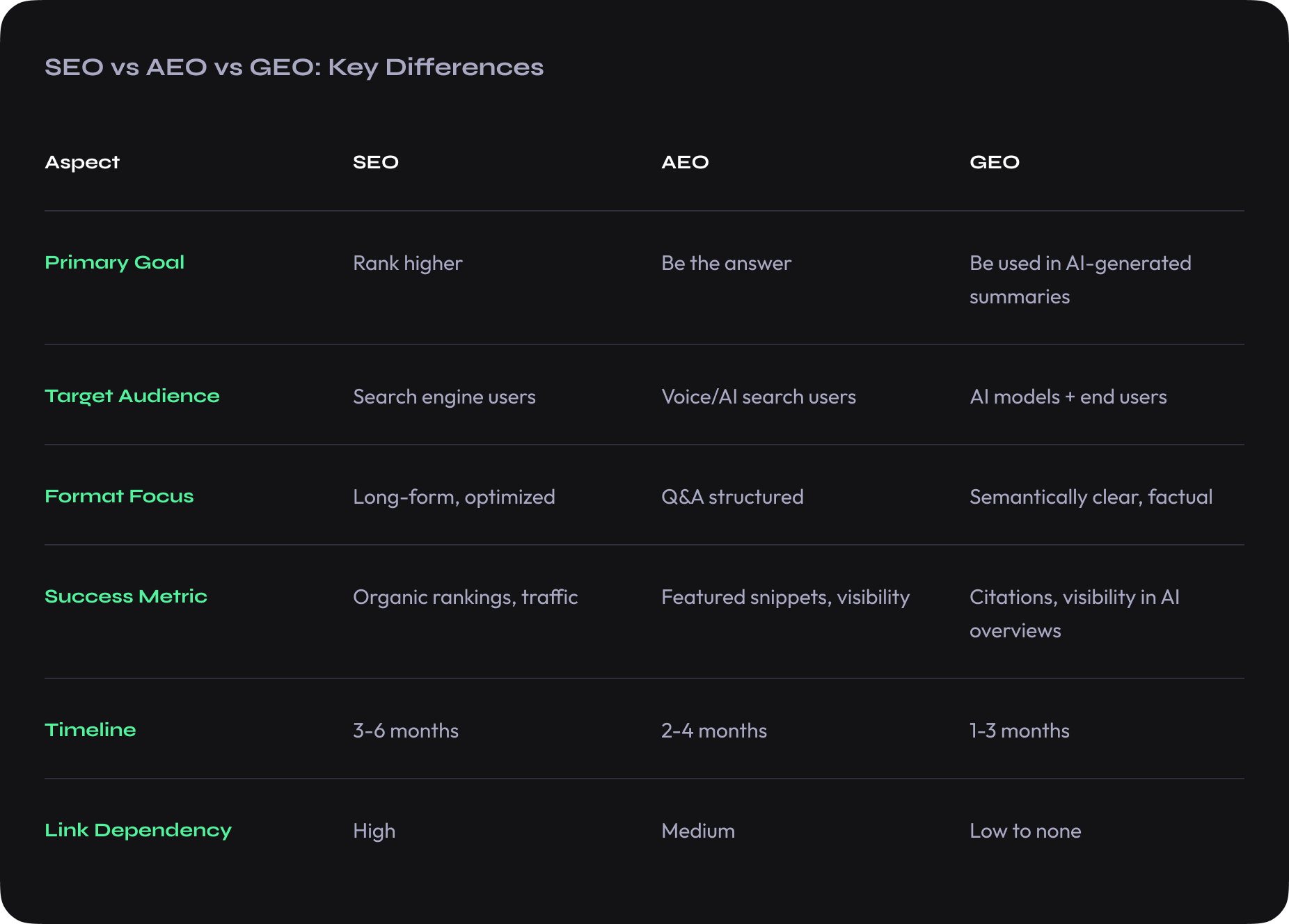
How SEO is Evolving: Understanding GEO and AEO in the Age of AI Search
Introduction
Search Engine Optimization (SEO) has long been the foundation of digital visibility. For over two decades, businesses have focused on keywords, backlinks, and on-page structure to climb the Google rankings. But the landscape is shifting - and fast. With the rise of AI-powered search experiences like Google SGE (Search Generative Experience) and ChatGPT Browse, the focus is no longer just about ranking. It’s about being the answer.
This shift has given rise to two complementary disciplines that marketers and SEO professionals must now understand: AEO (Answer Engine Optimization) and GEO (Generative Engine Optimization). In this article, we’ll break down what these mean, how they differ from traditional SEO, and how you can use them to prepare your business for the AI-first search future.

What is AEO (Answer Engine Optimization)?
AEO is all about formatting your content to directly and clearly answer users’ questions.
The goal of AEO is to be featured in answer-driven environments:
- Google Featured Snippets
- Voice search results (Siri, Alexa, Google Assistant)
- FAQ boxes and People Also Ask (PAA) panels
Key AEO tactics include:
- Using clear H1-H3 question formats
- Structuring content in concise paragraphs or bullet lists
- Adding FAQ schema markup
- Including short, direct answers at the top of pages
Real-world impact:
- A study by Backlinko found that the average Featured Snippet is 40-50 words long.
- Voice search answers are 2.7x more likely to come from content using schema markup.
AEO is about intent-matching at speed. If your content delivers the clearest, fastest answer, it gets rewarded.

What is GEO (Generative Engine Optimization)?
GEO is a newer concept focused on how your content interacts with AI-driven search models like Google SGE, Bing Chat, and ChatGPT with browsing capabilities.
The goal of GEO is to ensure your content:
- Is cited or quoted by AI summaries
- Is used as a trustworthy, structured source for generative answers
- Gets visibility without needing a traditional ranking
Key GEO tactics include:
- Semantic clarity (write in natural, precise language)
- Clean content structure (subheadings, lists, and tables)
- Transparent data (sourceable stats, references, and context)
- Authority signals (brand trust, authorship, E-E-A-T)
Case study: An AI flashcards tool page optimized for GEO
- Structured with semantic HTML and clear intents
- Entirely AI-written but tailored for Google SGE patterns
- Result: Top 5 positions for “ai flashcards generator” and ~3,000 organic visits/month without backlinks
GEO is not about gaming the system. It’s about helping AI understand and use your content correctly.

Why This Matters: The Shift in Search Behavior
The way people interact with search engines is fundamentally changing - and the numbers back it up.
- According to Google, over 15% of all daily search queries are brand new - never searched before.
- Longer, question-style queries (6+ words) have grown by over 60% in the past 5 years.
- 65% of users now say they want more concise, direct answers in search results (source: Statista, 2024).
- 31% of U.S. adults regularly use voice search (Pew Research, 2023), which relies heavily on answer-formatted content.
- Google SGE is already live in over 120 countries and is expected to reach over 1 billion users by the end of 2025.
- In internal Google tests, SGE reduced the need to click through results by over 40% for certain informational queries.
What does this mean for your content?
It means that ranking #1 may no longer guarantee traffic. If your content doesn’t make it into the AI-generated summary, or isn’t formatted for answer extraction, you may never get seen - even if you rank.
Instead of fighting for top positions, smart brands are now fighting to be understood, structured, and surfaced by AI models.
The rise of SGE and generative search means we are moving into a world of:
- Zero-click answers
- AI summarizations
- Source-based trust rather than link-based authority
This shift isn’t coming. It’s already happening.
How to Prepare Your Website
If you’re a brand, publisher, or SaaS business, here are 7 concrete steps to future-proof your content strategy for GEO and AEO:
1. Audit Existing Content for Answer Potential
- Identify pages that already perform well in organic search.
- Evaluate whether each page clearly answers a specific query or topic in the first 100 words.
- Use tools like AlsoAsked and SEMrush’s “Featured Snippet” report to find optimization opportunities.
2. Add Structured Data Markup
- Use FAQPage, HowTo, and Article schema to explicitly define content structure for search engines and AI.
- Implement JSON-LD via CMS or manually for precision.
3. Break Up Long Content
- Avoid walls of text. Use subheadings, lists, callouts, and summaries to make scanning easier - for both humans and algorithms.
- Include “TL;DR” summaries or key takeaways at the top.
4. Focus on Intent-Matching
- Use intent-based keyword clustering to match informational, transactional, and navigational queries.
- Ensure each page serves a single dominant intent without trying to do too much.
5. Boost Topical Authority and E-E-A-T
- Add expert bios, contributor pages, and source citations.
- Link to other high-authority or official resources to support AI trust signals.
- Use consistent brand identity and author signatures across pages.
6. Create Answer Blocks & Snippet Targets
- Write short, 40–60 word paragraphs that can serve as direct answers.
- Use numbered lists and tables when applicable - AI loves structure.
7. Monitor AI Citations and Visibility
- Use GSC, Bing Webmaster Tools, and tools like Authoritas or SerpApi to track how often your site is used in SGE and other generative contexts.
- Track clickless impressions and engagement changes.
These steps are not just tactical - they reflect a shift in how content should be planned, written, and optimized in a world where AI determines visibility.

Final Thoughts
GEO and AEO aren’t replacing SEO - they’re evolving it.
If you continue focusing only on rankings and backlinks, you risk becoming invisible in AI-powered interfaces. But if you create content that answers, teaches, and structures itself for machines, you unlock reach far beyond traditional SERPs.
At Leadige, we’re already helping clients adapt to this shift - optimizing pages that get featured by both Google and AI.
Want to know how ready your site is for the new wave of search?
Reach out for a free GEO/AEO audit - and let’s bring your content into the AI era.











